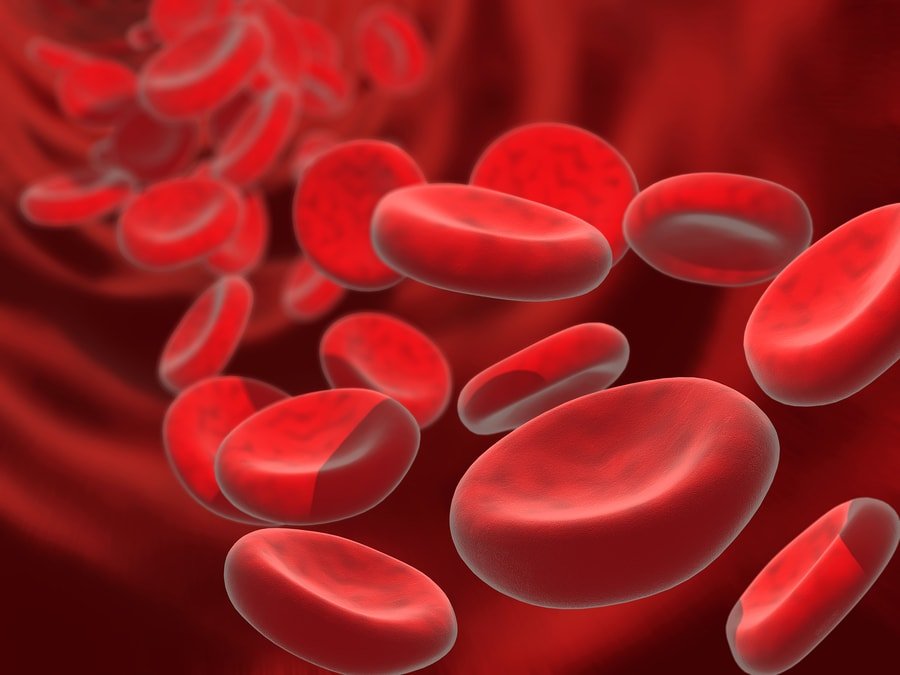
Hematocrit is the percentage of red blood cell volume compared to your total blood volume. Red blood cells carry oxygen throughout the body to help power biological functions. More oxygen may mean improved cognition and increased endurance.
What Is Hematocrit?
Hematocrit (also called HCT, packed cell volume, or PCV) is measured by routine lab tests. It is the percentage of red blood cells in your blood or, in other words, the volume of red blood cells divided by the total blood volume [1, 2, 3].
Red blood cells come from the bone marrow, where they are made from stem cells. The body makes about 2 million red blood cells every second. Every red blood cell lives about 120 days and then eventually ages, dies, and is broken down by the spleen [4].
Red blood cells carry oxygen, so an increase in hematocrit also increases the ability of the blood to carry oxygen. However, higher hematocrit also increases the thickness (viscosity) of blood, reducing its ability to flow through small blood vessels and reach the tissues in the body. Therefore, higher hematocrit isn’t always better for health [5].
Hematocrit affects a variety of processes, from throwing off the accuracy of blood sugar measurements to controlling the behavior of platelets and blood clotting proteins [6, 7, 8].
Based on a hematocrit measurement, it is possible to calculate other values that are used to predict, estimate, or evaluate [9, 10, 11, 12, 13, 14, 15, 16]:
- Disease risk
- Disease severity
- Surgery-related risks
- Blood viscosity (which is related to blood flow)
- Blood loss
- Rate of treatment (e.g., a dose) needed
Test results vary based on a number of factors, ranging from what kind of device is used to take the measurement to whether you have been drinking enough fluids [17, 2].
Dehydration is a common cause of high hematocrit results [2].
Sitting up (as opposed to lying down) during a blood draw can also increase your results [18].
Normal Values
Lab results are commonly shown as a set of values known as a “reference range”, which is sometimes referred to as a “normal range”. A reference range includes the upper and lower limits of a lab test based on a group of otherwise healthy people.
Your healthcare provider will compare your hematocrit levels with reference values to see if your results fall outside the range of expected values. By doing so, you and your healthcare provider can gain clues to help identify possible conditions or diseases.
Remember that some lab-to-lab variability occurs due to differences in equipment, techniques, and chemicals used. Don’t panic if your result is slightly out of range in the app – as long as it’s in the normal range based on the laboratory that did the testing, your value is normal.
However, it’s important to remember that a normal test doesn’t mean a particular medical condition is absent. Your doctor will interpret your hematocrit results in conjunction with your medical history and other test results.
But remember that a single test isn’t enough to make a diagnosis. Your doctor will interpret this test, taking into account your medical history and other tests. A result that is slightly low/high may not be of medical significance, as this test often varies from day to day and from person to person.
Normal hematocrit ranges are 40 to 54% for men, 36 to 48% for women, and 30 to 43% for children [2].
However, typical hematocrit can vary between populations depending on both genetic and environmental factors as well as the different measurement techniques used [19].
Hematocrit can vary from day to day or on a more long-term basis depending on altitude, season, athletic training, diet, and pregnancy, among other factors [20, 21, 22, 23, 24].
Hematocrit is a useful diagnostic tool because it can change in generally predictable ways with a health problem [25].
Polycythemia
In polycythemia, your blood contains a higher-than-normal proportion of red blood cells. Polycythemia can be “primary,” meaning that there is a problem with the way that your body is making red blood cells, or “secondary,” meaning that the problem is an adjustment to some other influence. For example, your body may be making more red blood cells because it’s not getting enough oxygen [26].
Symptoms of polycythemia can include:
High hematocrit can increase eye pressure, PO2 (the amount of oxygen in your blood), muscle oxygenation, and hand grip strength [27, 28, 29, 30].
High hematocrit can reduce the rate of clearance of a drug from your body and slow down blood flow [31, 32].
The following conditions are commonly associated with high hematocrit levels, but this single symptom is not enough for a diagnosis. Work with your doctor to discover what underlying condition might be causing your unusually high value in this test and to develop an appropriate plan to improve your health:
- Capillary leak syndrome (leaky blood vessels) [33]
- Congenital adrenal hyperplasia (misregulated steroid hormones) [34]
- Cystic fibrosis [35]
- Dengue fever [36]
- Ebola [37]
- Eclampsia (pregnancy complications) [38]
- Erythrocytosis (high red blood cells) [39]
- Heart disease
- Hypertension (high blood pressure) [40]
- Hyponatremia (low blood sodium) [41]
- Hypoxia (low oxygen) [42, 43]
- Insulin resistance [44]
- Metabolic syndrome [45]
- Mountain sickness (at high altitudes) [46]
- Non-alcoholic fatty liver disease [47]
- Necrotizing pancreatitis (e.g., from alcohol abuse) [48, 49]
- Sleep apnea (breathing pauses during sleep) [50]
- Ovarian hyperstimulation syndrome (e.g., from fertility treatments) [51]
- Kidney disease [52]
- Polycythemia vera (a blood cancer) [53]
- Posterior reversible encephalopathy syndrome (e.g., from high blood pressure) [54, 55]
- Postpartum depression [56]
- Prediabetes [57]
- Retinopathy (eye blood vessel damage) [58]
- Shock [59]
- Thrombocythemia (high platelets)
- Thrombosis (blood clot) [60]
When High Levels Are Good
High hematocrit has a number of potential health benefits. It can:
- Increase cognitive function [61]
- Improve athletic performance [62]
- Reduce aging [63]
- Reduce the risk of ulcers [64]
- Reduce the risk of cavities [65]
- Reduce the risk of death from heart failure [66]
When High Levels Are Bad
The following diseases have been associated with high hematocrit levels. Remember that the studies haven’t established this parameter as their cause. Having a high hematocrit value doesn’t necessarily mean that you will develop these conditions:
- Stroke [67]
- Heart disease [68]
- Poor outcomes in amyotrophic lateral sclerosis [69]
- Poor outcomes in sepsis (inflammatory response to infection) [70]
- Poor outcomes in gangrene [71]
Anemia
Low hematocrit, or anemia, can be caused by blood loss, the body making fewer red blood cells, or increased destruction of red blood cells. Symptoms of anemia can include difficulty breathing, dizziness, headache, cold skin, pale skin, and chest pain [72].
In some cases, anemia can be signaled by pica, a craving for unusual foods or nonfood substances (e.g., ice, crunchy foods, salty foods, clay, dirt) that goes away with iron supplementation [73].
The following conditions are commonly associated with low hematocrit levels, but this single symptom is not enough for a diagnosis. Work with your doctor to discover what underlying condition might be causing your unusually low value in this test and to develop an appropriate plan to improve your health:
- Alzheimer’s disease [74]
- Anemia [75]
- Arthritis
- Autism spectrum disorder [76]
- Bipolar disorder [77]
- Bone marrow disorders
- Cerebral palsy [78]
- Cirrhosis (liver disease) [79]
- Depression [80]
- Dyspepsia (stomach problems) [81]
- Dyspnea (breathing problems) [82]
- Fibromyalgia [83]
- Growth hormone deficiency [84]
- Hematoma (abnormal collection of blood) [85]
- Hemophilia (a bleeding disorder) [86]
- HIV [87]
- Hypotension (low blood pressure) [88]
- Hypothermia [89]
- Infection
- Inflammatory diseases
- Kidney disease or failure [90]
- Leukemia
- Massive blood loss (e.g., from trauma, cancer, internal bleeding)
- Nutritional deficiency (e.g., low iron, folic acid, vitamin B12) [79]
- Parasitemia (parasites in the blood, e.g., in malaria) [91]
- Periodontitis (gum disease) [92]
- Sepsis (inflammatory response to infection) [93]
- Shock
- Sickle cell disease [94]
- Systemic sclerosis (an autoimmune disease) [95]
- Thalassemia
- Type 1 diabetes [96]
When Low Levels Are Good
Low hematocrit has some potential health benefits. It can [62, 97]:
- Increase VO2 max (the maximum amount of oxygen you can use during intense exercise)
- Reduce the risk of seizures
When Low Levels Are Bad
There are health risks associated with low hematocrit. Low hematocrit can increase the length of hospital stay after surgery. It also can increase the risks of [98]:
- Complications from surgery [99]
- Surgical site infection [100]
- Hospital readmission after surgery [101]
- Need for blood transfusion [102]
- Tuberculosis [103]
- Ischemia (restricted blood flow to part of the body) [104]
- Poor outcome from injury [105, 106]
- Poor outcome from pneumonia [107]
Remember that the studies haven’t established this parameter as the cause of these complications. Having a high hematocrit value doesn’t necessarily mean that you will develop these conditions.
How to Increase Hematocrit
You may be increasing your hematocrit, or naturally have higher hematocrit, without realizing it. This may be due to:
- Adjusting to a high altitude [108]
- Alcohol consumption [109]
- Being male [110]
- Being overweight [111]
- Mental stress [112]
- Military training [113]
- Smoking cigarettes [114]
- Spaceflight [115]
- Workplace pollution [116, 117]
- Your sleeping position (head tilted downward) [118]
How to Increase Levels Naturally
If your hematocrit value is too low, the most important thing is to work with your doctor to find out what’s causing this low value and to treat any underlying conditions. The additional lifestyle changes listed below are other strategies you may want to discuss with your doctor. None of them should ever be implemented in place of what your doctor recommends or prescribes!
You can increase your hematocrit by consuming foods or supplements that increase iron. For example, you can increase your hematocrit by eating or drinking [119]:
- Almonds
- Artichokes
- Beans
- Chickpeas
- Dried fruit
- Fermented foods
- Fish and shellfish
- Flaxseed oil
- Green, leafy vegetables
- Iron-fortified foods
- Lentils
- Millet (shown by an animal study)
- Molasses
- Pomegranate juice
- Prune juice
- Pumpkin seeds
- Soybeans or tofu
Because vitamin C helps the body absorb iron, you can increase hematocrit by consuming fruits and vegetables that are rich in vitamin C, such as [119]:
- Broccoli
- Brussels sprouts
- Cabbage
- Cantaloupe
- Kiwi
- Peppers
- Potatoes
- Strawberries
- Tomatoes
In addition, copper helps prevent anemia by helping with iron storage and absorption. You can increase hematocrit by consuming foods that are rich in copper, such as:
- Cashews
- Sesame seeds
- Shiitake mushrooms
- Sunflower seeds
- Tempeh
- Walnuts
Medical Treatments that Increase Levels
Hematocrit can be increased medically with:
- Blood transfusion (e.g., blood doping) [120]
- Erythropoietin treatment [121, 122]
- Norepinephrine [123]
- Testosterone therapy [124]
These treatments often have other purposes than increasing hematocrit levels and must always be conducted under medical supervision.
Drugs That Increase Levels
Some drugs may increase your hematocrit value if you are already taking them for some other health condition, but never start taking them or increase your dose for this purpose. Always follow the treatment plan prescribed by your doctor.
Drugs used for treating hypogonadism (inadequate testosterone), organ transplant recipients, anemia, surgical blood loss (reducing blood loss), uterine fibroids, Crohn’s disease, and arthritis can increase hematocrit [125, 126, 127, 128, 129, 130, 131, 132].
Hematocrit can also be increased as a result of taking:
- Dogmatil [133]
- Hydroxyurea [134]
- Polyethylene glycol [135]
- Sodium-glucose cotransporter 2 inhibitors [136]
- Steroids [137]
- Tongkat Ali [138]
- Tranexamic acid [139]
How to Reduce Hematocrit
You may be reducing your hematocrit without realizing it due to:
- Being a farmer [140]
- Being a trained athlete [141]
- Being pregnant [142]
- Contaminated drinking water [143]
- Exposure to allergens [144]
- Workplace pollution [145]
How to Reduce Hematocrit Naturally
If your hematocrit value is too high, the most important thing is to work with your doctor to find out what’s causing this high value and to treat any underlying conditions. The additional lifestyle changes listed below are other strategies you may want to discuss with your doctor. None of them should ever be implemented in place of what your doctor recommends or prescribes!
You can reduce your hematocrit through the following dietary modifications:
- Avoiding iron supplements [146]
- Eating more bran (it interferes with iron absorption) [147]
- Staying hydrated [148]
- Avoiding alcohol [109]
- Eating more grapefruit [149]
- Getting more antioxidants [150]
Additionally, you can try the following lifestyle interventions:
Medical Treatments that Reduce Levels
Hematocrit can be reduced medically by (or as a side-effect of):
- Blood donation [154]
- Anesthesia [123]
- Cardiopulmonary bypass (artificial circulation during surgery) [155, 156]
- Immunoglobulin treatment [157]
- Positive airway pressure therapy for sleep apnea [158]
- Radiation therapy [159]
These treatments often have other purposes than lowering hematocrit levels and must always be conducted under medical supervision.
Drugs That Reduce Levels
Some drugs may reduce your hematocrit value if you are already taking them for some other health condition, but never start taking them or increase your dose for this purpose. Always follow the treatment plan prescribed by your doctor.
Drugs for mountain (altitude) sickness, polycythemia vera (a blood cancer), type 2 diabetes, male contraception, and malaria can reduce hematocrit [160, 161, 162, 163, 164].
Hematocrit can also be reduced as a result of taking:
- ACE inhibitors (for, e.g., high blood pressure) [165]
- Aspirin [166]
- Desmopressin [167]
- Finasteride [168]
- Glycerol [169]
- Ibuprofen [170]
- Metformin [171]
- Misoprostol [172]
- Rivaroxaban [173]
- Tocolytic agents [174]
Hematocrit Genetics
Hematocrit levels are influenced by your genes.
If you’ve gotten your genes sequenced, SelfDecode can help you determine if your levels are high or low as a result of your genes, and then pinpoint what you can do about it.
If you’re sick and tired of guessing about your health, SelfDecode can help you find specific answers that conventional doctors/diagnostics may never uncover.
| Gene | SNPs | Effect |
| ABO | rs2073823 | Hematocrit higher for AA genotype [175] |
| AKT3 | rs4590656 | Hematocrit higher for CT genotype [176] |
| AQP1 | rs1049305 | Hematocrit higher for GG genotype [175] |
| AQP1 | rs10244884 | Hematocrit higher for TT genotype [175] |
| EPAS1 | rs6756667 | Hematocrit higher for GG genotype, compared to AG genotype, during the development of mountain sickness [177] |
| EPO | rs551238 | Hematocrit higher with G allele [178] |
| EPO | rs1617640 | Hematocrit higher with G allele [178] |
| EPO | rs62483572 | Lower hematocrit with D70N mutation [179] |
| EPOR | rs121918116 | Hematocrit higher with A allele [180] |
| FTO (“Fat Gene”) | rs9939609 | Hematocrit decreases more dramatically for the AA or AT genotype, compared to the TT genotype, with diet and exercise [181] |
| G6PD | rs1050828 | Lower hematocrit with T allele, compared to A allele, for African Americans [182] |
| GNB3 | rs5443 | Hematocrit higher with T allele [183] |
| JAK2 | rs12343867
rs12340895 rs3780374 rs4495487 rs10974944 |
Hematocrit higher with JAK2V617F mutation [184] |
| ND2 | rs28357984 (Mt5178) | Higher hematocrit with A allele, compared to C allele [185] |



